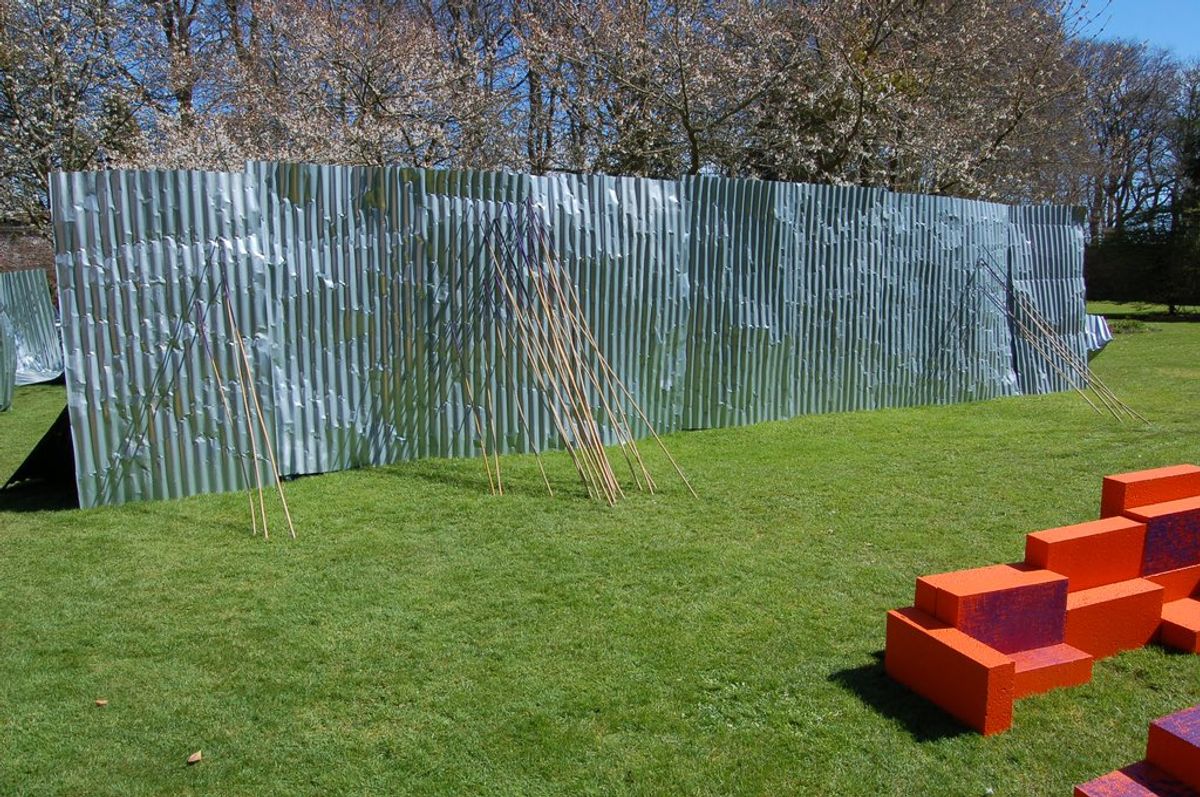The Scottish artist Mary Redmond has filed a copyright claim against the National Galleries of Scotland in Edinburgh (NGS) for showing a work by the Barbadian-Scottish artist Alberta Whittle, which includes metal corrugated panels handcrafted by Redmond.
Redmond has also filed a copyright claim against Whittle, who declined to comment due to the ongoing nature of the legal proceedings.
The panels were first installed as part of Redmond’s installation, The Venny The Jumps, at Hospitalfield House Arts Centre in Arbroath, Scotland in 2018. Redmond says shaping and marking each panel “took one month of intensive working on site” and believes they constitute sculpture.
After the exhibition finished, Redmond says an agreement was reached through email correspondence with the director of Hospitalfield, Lucy Byatt, that the metal panels could be “disposed of”. Redmond suggested they could possibly be recycled, though she says she received no response to this proposal.
The agreement was broken, Redmond says, when Byatt gave her metal panels to Whittle “without my knowledge or permission”. In a statement, Hospitalfield says: “Our understanding was that these materials were left behind and available for recycling or reuse. In the six months after this communication, although we were in touch quite often about other matters, Mary gave no indication that the materials were anything more than waste material.”
The statement notes that Redmond “refused to talk to or meet with Hospitalfield staff and Alberta Whittle for discussion”. It continues: “We consider Mary Redmond’s claims and allegations of copyright infringement against Alberta Whittle to be unfounded and without merit. Legal advice reinforces this view.”

Alberta Whittle's work at NGS re-used parts of Redmond's 2018 installation.
© Twitter/Mary Redmond
Redmond was first alerted to the fact that Whittle had used ten of her panels in 2019 when Whittle had a show at Dundee Contemporary Arts. Two works by Whittle, one based on a typical Barbadian chattel house, incorporated the metal panels, which had been flattened and washed down. Initially, Redmond says she chose to not challenge Whittle because she didn't want to be responsible for another artist's work being taken down.
However, after one of the pieces was shown at Glasgow's Museum of Modern Art in 2022, Redmond approached the gallery. She also contacted Whittle in September 2022, requesting that she stop “using her work and displaying it as her own”. Redmond says attempts to engage Whittle in mediation failed.
In April 2023, Whittle again exhibited her work incorporating the panels at the NGS. A month later, Redmond contacted Whittle asking her to stop using her art work and claiming it as her own. After receiving no response, Redmond sent a cease and desist letter.
In her claim, Redmond notes that the parts of her work that have been used “are substantial and can be clearly identified by the marks I made on them as my artistic expression”. Growing up in a working class area of Glasgow, Redmond also notes how corrugated metal was a part of the industrial landscape of her childhood. “I choose to work with this material as it represents my culture,” Redmond adds.
An NGS spokesperson says “it would be inappropriate for us to comment further at this time due to ongoing legal proceedings”. They add: "Alberta Whittle is a significant and influential artist in Scotland and internationally, whose practice has had a profound impact on the artistic community in this country. NGS is proud to be sharing [her] work."
Redmond says several renowned arts professionals have recognised the metal panels as her work and believe the art should be returned. The Scottish artist Karla Black says: “This sad situation highlights a problem that we have in the art world: we lack a culture of consent.”
Black adds: “Two artists have been put in terrible positions here because of a lack of understanding, on the part of arts organisations and institutions, about the nature of what art really is. If curators and gallerists who have admired and supported Mary Redmond's work for more than 20 years can mistake parts of a sculpture for ‘material’ then that's alarming. I would expect art professionals to be educated about the nature of abstract materialism.”
Black is hopeful for a positive outcome, suggesting that Scottish arts institutions and public funding bodies “could come together and write some documentation or legislation that embeds the artist's consent into the exhibition process, from beginning to end”. She adds: “This needs to be very specific, signed consent about how work will be returned to them, who will cover the costs of that return and what it is acceptable to do with the work after the end of the exhibition if it is, in fact, to be disposed of.”


